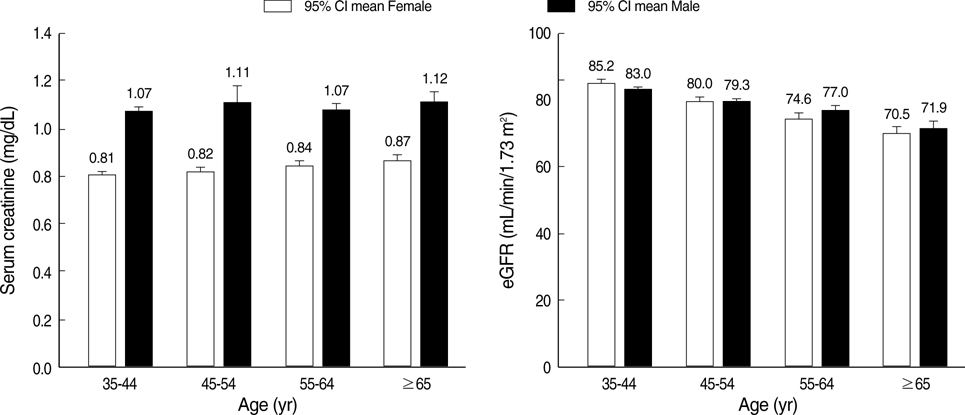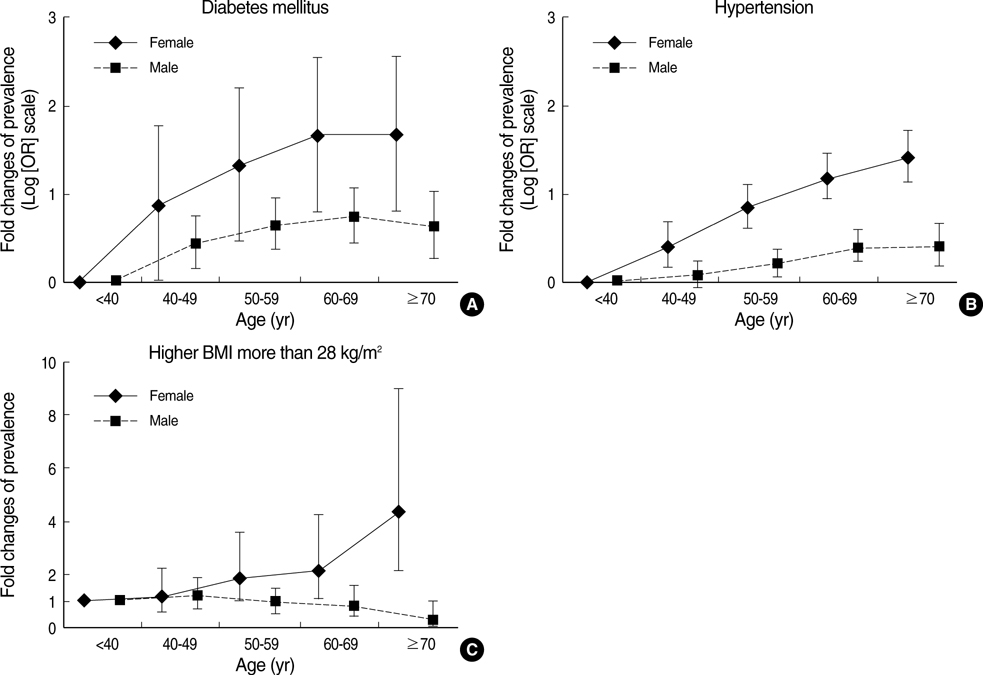The Prevalence of Chronic Kidney Disease (CKD) and the Associated Factors to CKD in Urban Korea: A Population-based Cross-sectional Epidemiologic Study
- Affiliations
-
- 1Department of Internal Medicine and Renal Institute, Seoul National University College of Medicine, Seoul, Korea. mednep@snubh.org
- 2Department of Internal Medicine, Seoul National University Boramae Hospital, Seoul, Korea.
- 3Department of Internal Medicine, SoonChunHyang University College of Medicine, Seoul, Korea.
- 4Department of Pediatrics, Konkuk University School of Medicine, Seoul, Korea.
- 5Department of Internal Medicine, Seoul National University Bundang Hospital, Seongnam, Korea.
- 6Department of Internal Medicine, Ewha Womans University College of Medicine, Seoul, Korea.
- 7Department of Internal Medicine, Korea University College of Medicine, Seoul, Korea.
- 8Department of Internal Medicine, Inje University College of Medicine, Seoul, Korea.
- KMID: 1778135
- DOI: http://doi.org/10.3346/jkms.2009.24.S1.S11
Abstract
- Chronic kidney disease (CKD) is a worldwide problem. This study was designed to survey the prevalence and risk factors for CKD in Korea. The 2,356 subjects were selected in proportion to age, gender, and city. Subjects 35 yr of age or older were selected from 7 cities. Estimated glomerular filtration rate (eGFR) was calculated using the Modification of Diet in Renal Disease (MDRD) Study equation, with albuminuria defined as a urine albumin to creatinine ratio of 30 mg/g or more. The overall prevalence of CKD was 13.7%. The prevalences of CKD according to stage were 2.0% stage 1, 6.7% stage 2, 4.8% stage 3, 0.2% stage 4, and 0.0% stage 5. The prevalences of microalbuminuria and macroalbuminuria were 8.6% and 1.6%, respectively. The prevalence of eGFR less than 60 mL/min/1.73 m2 was 5.0%. Age, body mass index (BMI), hypertension, diabetes mellitus, systolic blood pressure (SBP), diastolic blood pressure (DBP), and fasting blood glucose were independent factors related to the presence of CKD. In conclusions, Korea, in which the prevalence of CKD is increasing, should prepare a policy for early detection and appropriate treatment of CKD. The present data will be helpful in taking those actions.
MeSH Terms
Figure
Cited by 6 articles
-
Association between Serum Uric Acid Level and ESRD or Death in a Korean Population
Kipyo Kim, Suryeong Go, Hyung Eun Son, Ji Young Ryu, Hajeong Lee, Nam Ju Heo, Ho Jun Chin, Jung Hwan Park
J Korean Med Sci. 2020;35(28):e254. doi: 10.3346/jkms.2020.35.e254.The Prevalence and Risk Factors of Renal Insufficiency among Korean HIV-Infected Patients: The Korea HIV/AIDS Cohort Study
Eun Jin Kim, Jin Young Ahn, Youn Jeong Kim, Seong-Heon Wie, Dae Won Park, Joon-Young Song, Hee Jung Choi, Hyun-Ha Chang, Bo Youl Choi, Yunsu Choi, Ju-yeon Choi, Myung Guk Han, Chun Kang, June Myung Kim, Jun Yong Choi,
Infect Chemother. 2017;49(3):194-204. doi: 10.3947/ic.2017.49.3.194.Klotho and Postmenopausal Hormone Replacement Therapy in Women with Chronic Kidney Disease
Yoo Jin Park, Jun-Mo Kim
J Menopausal Med. 2018;24(2):75-80. doi: 10.6118/jmm.2018.24.2.75.Higher Prevalence and Progression Rate of Chronic Kidney Disease in Elderly Patients with Type 2 Diabetes Mellitus
Kyung-Soo Kim, Seok Won Park, Yong-Wook Cho, Soo-Kyung Kim
Diabetes Metab J. 2018;42(3):224-232. doi: 10.4093/dmj.2017.0065.Chronic Kidney Disease and Hepatitis B Virus Surface Antigenemia
Sung Woo Lee, Ho Jun Chin
J Korean Med Sci. 2018;33(42):. doi: 10.3346/jkms.2018.33.e274.Baseline renal function as a prognostic indicator in patients with newly diagnosed diffuse large B-cell lymphoma
Junshik Hong, Sojung Lee, Gayoung Chun, Ji Yong Jung, Jinny Park, Jeong Yeal Ahn, Eun Kyung Cho, Dong Bok Shin, Jae Hoon Lee
Blood Res. 2016;51(2):113-121. doi: 10.5045/br.2016.51.2.113.
Reference
-
1. Coresh J, Selvin E, Stevens LA, Manzi J, Kusek JW, Eggers P, Van Lente F, Levey AS. Prevalence of chronic kidney disease in the United States. JAMA. 2007. 298:2038–2047.
Article2. Chadban SJ, Briganti EM, Kerr PG, Dunstan DW, Welborn TA, Zimmet PZ, Atkins RC. Prevalence of kidney damage in Australian adults: the AusDiab kidney study. J Am Soc Nephrol. 2003. 14:7 Suppl 2. S131–S138.
Article3. Imai E, Horio M, Iseki K, Yamagata K, Watanabe T, Hara S, Ura N, Kiyohara Y, Hirakata H, Moriyama T, Ando Y, Nitta K, Inaguma D, Narita I, Iso H, Wakai K, Yasuda Y, Tsukamoto Y, Ito S, Makino H, Hishida A, Matsuo S. Prevalence of chronic kidney disease (CKD) in the Japanese general population predicted by the MDRD equation modified by a Japanese coefficient. Clin Exp Nephrol. 2007. 11:156–163.
Article4. Zhang L, Zhang P, Wang F, Zuo L, Zhou Y, Shi Y, Li G, Jiao S, Liu Z, Liang W, Wang H. Prevalence and factors associated with CKD: a population study from Beijing. Am J Kidney Dis. 2008. 51:373–384.
Article5. Go AS, Chertow GM, Fan D, McCulloch CE, Hsu CY. Chronic kidney disease and the risks of death, cardiovascular events, and hospitalization. N Engl J Med. 2004. 351:1296–1305.
Article6. Foley RN, Murray AM, Li S, Herzog CA, McBean AM, Eggers PW, Collins AJ. Chronic kidney disease and the risk for cardiovascular disease, renal replacement, and death in the United States medicare population, 1998 to 1999. J Am Soc Nephrol. 2005. 16:489–495.
Article7. Shlipak MG, Sarnak MJ, Katz R, Fried LF, Seliger SL, Newman AB, Siscovick DS, Stehman-Breen C. Cystatin C and the risk of death and cardiovascular events among elderly persons. N Engl J Med. 2005. 352:2049–2060.
Article8. Sarnak MJ, Levey AS, Schoolwerth AC, Coresh J, Culleton B, Hamm LL, McCullough PA, Kasiske BL, Kelepouris E, Klag MJ, Parfrey P, Pfeffer M, Raij L, Spinosa DJ, Wilson PW. Kidney disease as a risk factor for development for cardiovascular disease-A statement from the American Heart Association Councils on kidney in cardiovascular disease, high blood pressure research, clinical cardiology, and epidemiology and prevention. Circulation. 2003. 108:2154–2169.9. Fried LF, Katz R, Sarnak MJ, Shlipak MG, Chaves PH, Jenny NS, Stehman-Breen C, Gillen D, Bleyer AJ, Hirsch C, Siscovick D, Newman AB. Kidney function as a predictor of noncardiovascular mortality. J Am Soc Nephrol. 2005. 16:3728–3735.
Article10. Madan P, Kalra OP, Agarwal S, Tandon OP. Cognitive impairment in chronic kidney disease. Nephrol Dial Transplant. 2007. 22:440–444.
Article11. Chin HJ, Song YR, Lee JJ, Lee SB, Kim KW, Na KY, Kim S, Chae DW. Moderately decreased renal function negatively affects the health-related quality of life among the elderly Korean population: a population-based study. Nephrol Dial Transplant. 2008. 23:2810–2817.
Article12. Moranne O, Froissart M, Rossert J, Gauci C, Boffa JJ, Heymann JP, M'rad MB, Jacquot C, Houillier P, Stengel B, Fouqueray B. NephroTest Study Group. Timing of onset of CKD-related metabolic complications. J Am Soc Nephrol. 2009. 20:164–171.
Article13. John R, Webb M, Young A, Stevens PE. Unreferred chronic kidney disease: a longitudinal study. Am J Kidney Dis. 2004. 43:825–835.
Article14. Hunsicker LG. The consequences and costs of chronic kidney disease before ESRD. J Am Soc Nephrol. 2004. 15:1363–1364.
Article15. Korean Society of Nephrology. ESRD Registry committee. Renal replacement therapy in Korea: insan memorial dialysis registry 2005. Korean J Nephrol. 2006. 25:S2. S425–S457.16. Brodsky J. International comparisons. Am J Kidney Dis. 2008. 51:Suppl 1. S239–S254.17. Levey AS, Bosch JP, Lewis JB, Greene T, Rogers N, Roth D. A more accurate method to estimate glomerular filtration rate from serum creatinine: a new prediction equation. Modification of Diet in Renal Disease Study Group. Ann Intern Med. 1999. 130:461–470.18. Kwan BC, Murtaugh MA, Beddhu S. Associations of body size with metabolic syndrome and mortality in moderate chronic kidney disease. Clin J Am Soc Nephrol. 2007. 2:992–998.
Article19. Coresh J, Astor BC, Greene T, Eknoyan G, Levey AS. Prevalence of chronic kidney disease and decreased kidney function in the adult US population: Third National Health and Nutrition Examination Survey. Am J Kidney Dis. 2003. 41:1–12.
Article20. Li ZY, Xu GB, Xia TA, Wang HY. Prevalence of chronic kidney disease in a middle and old-aged population of Beijing. Clin Chim Acta. 2006. 366:209–215.
Article21. Imai E, Horio M, Nitta K, Yamagata K, Iseki K, Tsukamoto Y, Ito S, Makino H, Hishida A, Matsuo S. Modification of the Modification of Diet in Renal Disease (MDRD) Study equation for Japan. Am J Kidney Dis. 2007. 50:927–937.
Article22. Ma YC, Zuo L, Chen JH, Luo Q, Yu XQ, Li Y, Xu JS, Huang SM, Wang LN, Huang W, Wang M, Xu GB, Wang HY. Modified glomerular filtration rate estimating equation for Chinese patients with chronic kidney disease. J Am Soc Nephrol. 2006. 17:2937–2944.
Article23. Wasen E, Isoaho R, Mattila K, Vahlberg T, Kivela SL, Irjala K. Estimation of glomerular filtration rate in the elderly: a comparison of creatinine-based formulae with serum cystatin C. J Intern Med. 2004. 256:70–78.
Article24. Viktorsdottir O, Palsson R, Andresdottir MB, Aspelund T, Gudnason V, Indridason OS. Prevalence of chronic kidney disease based on estimated glomerular filtration rate and proteinuria in Icelandic adults. Nephrol Dial Transplant. 2005. 20:1799–1807.
Article25. Chin HJ, Oh KH, Oh YK, Na KY, Joo KW, Lim CS, Kim YS, Chae DW, Ahn C, Han JS, Lee JS, Kim S. The Prevalence and the Associated Disorders of Chronic Kidney Disease in Subjects with Health Check-Up. Korean J Nephrol. 2007. 26:195–203.26. Iseki K, Iseki C, Ikemiya Y, Fukiyama K. Risk of developing end-stage renal disease in a cohort of mass screening. Kidney Int. 1996. 49:800–805.
Article27. Coresh J, Byrd-Holt D, Astor BC, Briggs JP, Eggers PW, Lacher DA, Hostetter TH. Chronic kidney disease awareness, prevalence, and trends among U.S. adults, 1999 to 2000. J Am Soc Nephrol. 2005. 16:180–188.
Article28. Domrongkitchaiporn S, Sritara P, Kitiyakara C, Stitchantrakul W, Krittaphol V, Lolekha P, Cheepudomwit S, Yipintsoi T. Risk factors for development of decreased kidney function in a southeast Asian population: a 12-year cohort study. J Am Soc Nephrol. 2005. 16:791–799.
Article29. Fox CS, Larson MG, Leip EP, Culleton B, Wilson PW, Levy D. Predictors of new-onset kidney disease in a community-based population. JAMA. 2004. 291:844–850.
Article30. Ramirez SP, McClellan W, Port FK, Hsu SI. Risk factors for proteinuria in a large, multiracial southeast Asian population. J Am Soc Nephrol. 2002. 13:1907–1917.
Article31. Ko GT, Tang J, Chan JC, Sung R, Wu MM, Wai HP, Chen R. Lower BMI cut-off value to define obesity in Hong Kong Chinese: an analysis based on body fat assessment by bioelectrical impedance. Br J Nutr. 2001. 85:239–242.
Article32. Kuo HW, Tsai SS, Tiao MM, Yang CY. Epidemiological features of CKD in Taiwan. Am J Kidney Dis. 2007. 49:46–55.
Article33. Iseki K, Iseki C, Ikemiya Y, Kinjo K, Takishita S. Risk of developing low glomerular filtration rate or elevated serum creatinine in a screened cohort in Okinawa, Japan. Hypertens Res. 2007. 30:167–174.
Article
- Full Text Links
- Actions
-
Cited
- CITED
-
- Close
- Share
- Similar articles
-
- Increased Prevalence of Chronic Kidney Disease in Subjects Undergoing Coronary Angiography
- Osteoporosis in Patients with Chronic Kidney Disease
- Sedentarism, A Modifiable Risk Factor for Developing Chronic Kidney Disease in Healthy People
- Prevalence of Hypothyroidism in Patients with Chronic Kidney Disease
- Determinants and burden of chronic kidney disease in a high-risk population in Korea: results from a cross-sectional study



